Introduction to Ho Chi Minh City – HCM City or Saigon is the largest, most exciting, and least sleepy (almost sleepless) city in Vietnam. People describe it as the “sleepless city” as the city and the Saigoneses seem to stay awake even after midnight, when the pubs, bars, restaurants, and street vendors still operate. It’s common to stop by a street vendor and have a bowl of “Hu Tieu Go” (a kind of rice vermicelli pork soup) or enjoy a cup of Saigon coffee. Saigon is the land for night owls who enjoy the late-night lifestyle, which might be hard to find elsewhere. Many individuals say that they miss Saigon so much after a trip to their countryside hometowns because there is no place like Saigon, in which they value freedom, exciting lifestyle, delicious food, and coffee at any time. This introduction to Ho Chi Minh City can serve as your handy guide whenever you come up with questions about its location, weather, quick history, best attractions, top food, and more. Besides rooftop bars, live-music pubs, and luxurious shopping malls, the city preserves its historical attractions. This makes it one of the most attractive cities on the planet that tourists always include on their bucket lists.
Overview of Ho Chi Minh City [Former Saigon]
Saigon functions as a primary economic and educational center of Vietnam and an attractive tourist destination highly ranked by domestic and international visitors. Also, the city serves as a major media and entertainment outlet that calls for the entire Vietnamese attention. None and nothing can ignore the significance of this city in Vietnam. It hosts the Tan Son Nhat International Airport, the busiest airport in the country, which makes Saigon a center of transportation. The city has modern landmarks beside the remnants of history, providing that there are many exciting things to see and do in the city named after Uncle Ho – Cho Chi Minh City. While Saigon Notre Dame Cathedral is the historical landmark and favorite hangout venue of the Saigoneses, Landmark 81 is a modern skyscraper with an amazing look and high-end services inside. The list of the must-sees in the city can be pages, so people will never get bored during their city adventures. One of the very first interesting things in Saigon is to know how to cross a road. The city streets are often packed with motorbikes and cars, so it might need skills and courage to cross the streets. Sometimes, it’s best to follow the local people, make a group, and together cross the roads. There are even online tips and how-tos on the ways to cross a busy street in Ho Chi Minh City. A simple walk along the roadsides will let you find many good food carts and street vendors that serve a diversity of yummy dishes. Saigon food is so delicious that almost every visitor enjoys, remembers, and revisits the city just because of the food.
Saigon or Ho Chi Minh City
The city has gone through several different names during the ups and downs of history, but Saigon and Ho Chi Minh City are the most common names used nowadays. Under the control of the Vietnamese, the city was officially named “Gia Dinh.” Until the period of the French conquest in the 1860s, the name Sai Gon (Saigon) was adopted.
The present name Ho Chi Minh City was first proclaimed in 1946 and later adopted after Reunification in 1976 to honor President Ho Chi Minh. Still commonly called Saigon in daily speech and normal writings, the city preserves the two names that it’s acceptable and widely recognized by almost every individual. Nonetheless, note that the official writings and business documents must use Ho Chi Minh City as the official name.
Introduction to Ho Chi Minh City ‘s Geographical Location
Ho Chi Minh City is nestled in the southeast of Vietnam, around 1,760km from Hanoi capital city. While the city center has an average elevation of 5m above sea level, the suburb areas are 16m above sea level. Ho Chi Minh City is encompassed by Tay Ninh Province and Binh Duong Province to the north, Dong Nai Province and Ba Ria – Vung Tau to the east, Long An Province to the west, Tien Giang Province and the East Sea to the south (with a 15km-long coast). It covers an area of 2,095 square kilometers, extending to Cu Chi District and down to Can Gio on the East Sea. With its location on the Mekong Delta, Saigon is supported by tidal flats, which have been adjusted for regional agriculture. What’s more, the city surrounds the Saigon River, which showers it with a beautiful riverscape for sightseeing, water bus ride, and luxurious cruise tours at night.
Weather Characteristics
Ho Chi Minh City features a tropical climate, with an average humidity of 78-82 percent. It has two distinct seasons in the year. While the rainy season lasts from May to November, the dry season runs from December to April. Its average temperature of the year is 28 Celsius degrees. April is when the city recorded the highest temperature of 40 Celsius degrees while January recorded the lowest one of 13.8 Celsius degrees. The sunshine amount of the city throughout the year is abundant, between 2,400 to 2,700 hours.
The climate change during the rainy season might bring the flood to the vulnerable areas of the city. The mixture of high tide, heavy rains, and strong flow volume in Saigon River and Dong River drive several parts of the city to face the flooding conditions.
Introduction to Ho Chi Minh City’s Best Time to Visit
There have been questions about the best time to visit Ho Chi Minh City, and most answers recommend you get there during the dry months (from December to March) when the peak season is also. It is when the local weather becomes pleasant with no sudden rain. Also, this period marks the celebrations of the Christmas holiday, Year-end parties, and then the Vietnamese Lunar New Year Festival (Tet) which often occurs in February. The exciting period is also associated with the increasing prices and frequently booked flights and hotel rooms. It is when tourists enjoy mingling with the cultural shows, decorations, fireworks, and lion dances on the streets. In general, the weather in Ho Chi Minh City can be described as follows:
- February is the driest month
- September is the rainiest month
- April is the hottest month
- December and January are the coolest months
So, if you ask for the exact best months to go, January and February rank top. They are the festival months with dry and pleasant weather in the year. This does not mean traveling to Saigon in the other months would be worse. The city remains exciting and sleepless to amaze tourists every time they come. While somebody arrives to get entertained in shopping malls and impressive skyscrapers, the others might enjoy Saigon Street Food (which is delicious all year round), and the rest might want a witness the historical remnants. Check your schedule and decide on when to go!
Introduction to Saigon History and Development
Before the Nguyen dynasty
The earliest settlement in the area was the Funanese, the Khmer, and the Cham. Then, the first Vietnamese people came to explore the land. Based on the marriage between Princess Nguyen Phuc Ngoc Van (daughter of Lord Nguyen Phuc Nguyen) and the King of Cambodia Chey Chettha II in 1620, the people of Vietnam and Cambodia could freely transport between the two countries. The Vietnamese settlers started to migrate to the regions.
Under the Nguyen dynasty
In 1679, Lord Nguyen Phuc Tan permitted the Chinese refugees to settle in the area of Saigon and adjacent areas (My Tho and Bien Hoa). In 1698, the Vietnamese noble Nguyen Huu Canh followed the Nguyen Lord’s orders to establish Vietnamese administrative systems in the area, thus separating the area from Cambodia. In 1788, the city was captured by Lord Nguyen Anh as a resistance center against Tay Son. Two years later, the citadel Gia Dinh was built by one of the French mercenaries of Nguyen Anh.
During Nguyen Van Khoi’s revolt 1833-1835 against Emperor Minh Mang, the Gia Dinh citadel was captured. After that, the citadel was dismantled, and a new citadel Phung Thanh was erected in 1836. Later, in 1859, the Phung Thanh citadel was destroyed by the French. In the 18th century, the city became Saigon.
During the French Colonial period
Granted to France by the 1862 Treaty of Saigon, the city was put under the French’s transformation plan into a town for colonization. Throughout the centuries of the 19th and the 20th, numerous French buildings were constructed, namely the Norodom Palace, Notre-Dame Cathedral, Ben Thanh Market, Hotel Continental, and more. This period also marked the establishment of the first newspaper published in Vietnam, Gia Dinh Bao. During this time, the city was referred to as the “Pearl of the Orient” or “Paris of the Extreme Orient.”
Republic of Vietnam period
In 1949, Emperor Bao Dai granted Saigon as the capital of the State of Vietnam while he was the head of the state himself. In 1954, based on the Geneva Agreement, the northern half of the country gained complete independence under Ho Chi Minh’s leadership. Meanwhile, the southern gained haft independence from France. In 1955, Bao Dai was deposed by his Prime Minister Ngo Dinh Diem, then the State of Vietnam became the Republic of Vietnam while Saigon was the capital. On 22 October 1956, the city was officially named “Do Thanh Sai Gon” (Saigon Capital City). Following the decrees on the administrative divisions, Saigon included districts and wards, of which several were combined. In 1959, the city was divided into 8 districts and 41 wards.
In the late 1950s, the Diem regime was supported by the U.S., so the local economy developed quickly under capitalism. By 1960, more than half of the factories in South Vietnam were in Saigon. At the beginning of the 1960s, the city suffered from an economic downturn and high inflation as it depended on U.S. aid and imports from other countries. There were attacks against the Diem regime, which resulted in more than 500 deaths and around 20,000 homeless. On 11 June 1963, Buddhist monk Thich Quang Duc burned himself in protest of the Diem regime. Consequently, on 1 November 1963, Ngo Dinh Diem was assassinated in Saigon. In 1975, Saigon fell which ended the Vietnam War, and the city was under the control of the Vietnamese People’s Army.
Modern Days
In 1976, the Socialist Republic of Vietnam was established. Saigon and its adjacent areas were combined to make Ho Chi Minh City, honoring Present Ho Chi Minh. At that time, the city included 8 districts and 5 rural areas. Then, its administrative divisions have been revised various times since 1978. In 2020, Districts 2, 9, and Thu Duc were integrated to form a municipal city. As of 2020, Ho Chi Minh City has 5 rural districts, 16 urban districts, and 1 municipal city. The city nowadays is majorly inhabited by the Vietnamese (the Kinh group) besides the ethnic groups of the Chinese who live in Cho Lon – District 5 and parts of Districts 6, 10, and 11. Other ethnic minorities include the Khmer and the Cham. Also, the city hosts other nationalities of Koreans, Americans, Japanese, South Africans, etc., who resided as expatriate workers.
The modern Ho Chi Minh City is supported by the strong transport systems of air (Tan Son Nhat International Airport), railway, water bus, public transport (metro and bus), and private transport (motorbikes, cars, taxies, and bicycles). Interestingly, for a short trip around the city, guests can enjoy the motorbike taxi (Xe Om) service. At present, the traditional “Xe Om” has been replaced by ride-hailing apps like Grab. Another means of transport for tourists is the cyclo on which the local riders will pedal and take tourists through the city landmarks.
Introduction to Ho Chi Minh City ‘s Most Famous Tourist Attractions
It takes a few days to enjoy the beat and sound of Saigon, ranging from the historical attractions to the modern constructions. The perfect blend of history and modern growth in the city provides tourists with a rich list of the highlights to see. Though not specifically mentioned in the top list, Saigon streets are the great venues to find the delectable street food, friendly merchants, and other foodies alike. There is even the unique Saigon Street Food Tour by a scooter through several districts, so you have a ride around the glittering city and eat the Saigon food in the evening.
Saigon Notre-Dame Cathedral
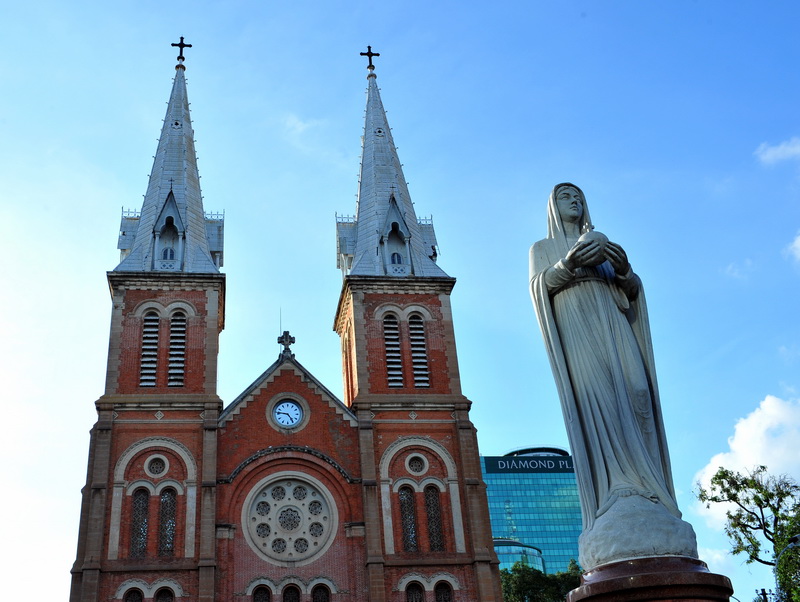
This cathedral was erected between 1863 and 1880 by the French colonists who named it the Church of Saigon. Later, the name Notre-Dame Cathedral was adopted in 1959. The site has two bell towers with a height of 58m. Originally, the church was used to serve as a community and religious center for French colonialists. All building materials of this brick construction were imported from France. The outside wall was built with bricks from Toulouse, featuring a bright red color. The total height of the construction to the top of the Cross is 60,5m. In front of the cathedral is a flower garden, which attracts visitors for sightseeing, photography, and hangout. Generations of the Saigoneses enjoy gathering and drinking coffees in the areas around the cathedral. People love chatting and taking pictures while marveling at the Catholic church. Getting inside, the stained-glass windows will amaze you with their sophisticated beauty.
Reunification Palace [former Independence Palace]
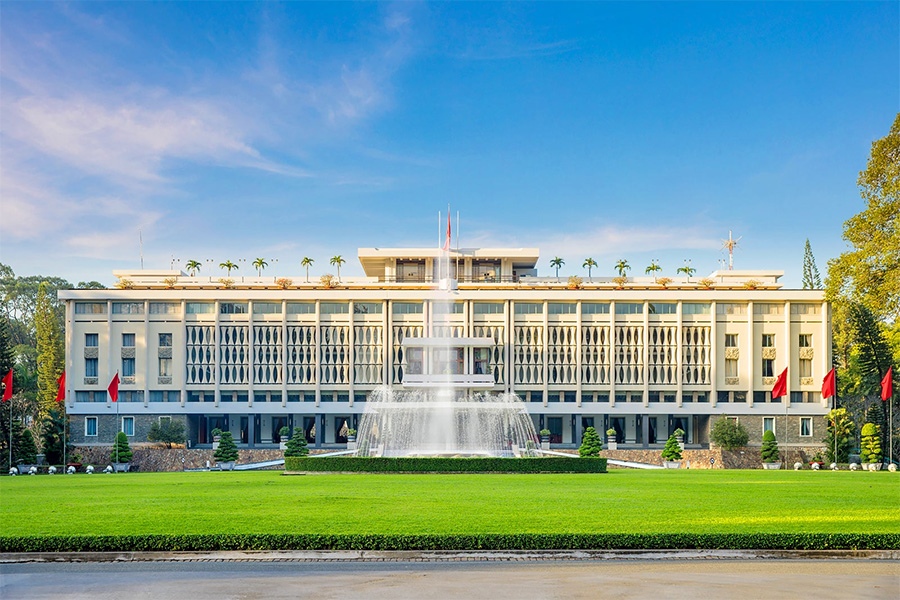
This place is linked to the history of Saigon and Vietnam. It was the home and workplace of the President of southern Vietnam and was the site of the Fall of Saigon on 30 April 1975 ending the Vietnam War. The historical timelines of the Independence Palace and its remnants on the spot are the rich resources for Vietnamese history projects that you might have. It went through the French protectorate, Republic of Vietnam, and the Socialist Republic of Vietnam periods. Later generations should always visit this historical witness, listen to the timelines, and take pictures inside. The Independence Palace is frequently visited by local students and foreign tourists. You’re likely to meet the lines of visitors who are exploring the historical landmark. Note that this site requires an entrance ticket.
Ben Thanh Market
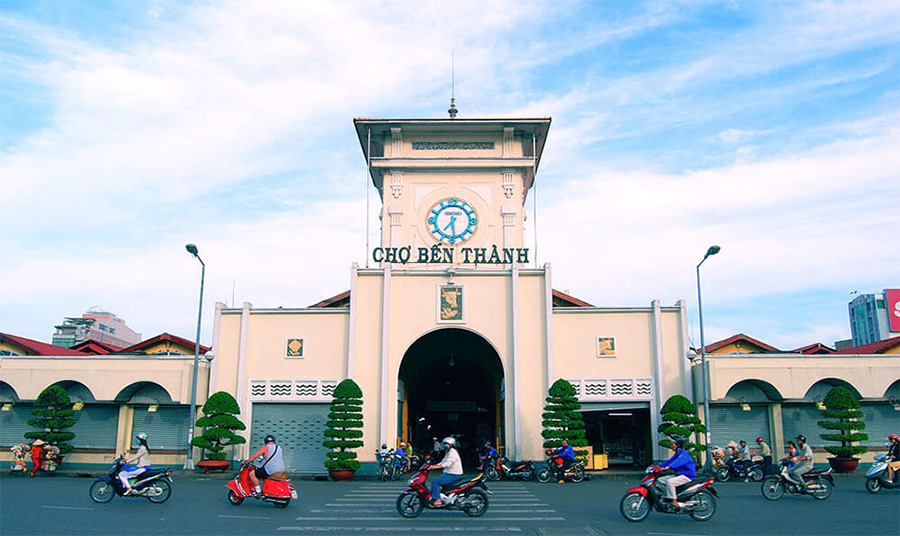
From basic supplies to souvenirs, Ben Thanh Market has been well-known among overseas tourists. Also, the market provides the historical and nostalgic feelings of the old Saigon time, when the commercial buildings and shopping malls do not exist. If you enjoy the traditional market atmosphere, Ben Thanh is a landmark to check-in. Though you might not feel like shopping in this spot, taking pictures in this market is a great activity. This is one of the earliest surviving structures in Saigon as well as a symbol of the city. There are more than 1,000 booths that sell almost every item from luxury goods to consumables. Located in the center of Ho Chi Minh City, Ben Thanh Market is easily accessible and highly recommended for first-time travelers. At the southern gate of the market, take note of the iconic clock tower, which is a must-photograph object.
Bitexco Financial Tower and Sky Deck
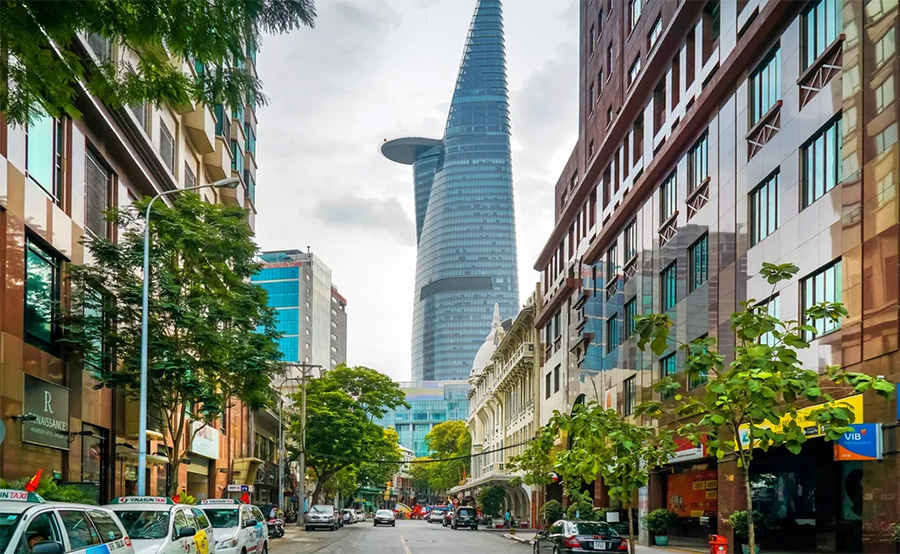
This is a pride of Saigon, which was once the tallest building in Vietnam as its completion in 2010. The skyscraper has 68 floors above ground and 3 basements, with a height of 262.5 meters. Nowadays, Bitexco Financial Tower is the second tallest building in Ho Chi Minh City, after the impressive Landmark 81. This tower is a property of Bitexco Group, a Vietnamese multi-industry cooperation. As said, the tower was designed by Carlos Zapata, who based the design on New York City and was inspired by the shape of the lotus – Vietnam’s national flower. The site was officially inaugurated on 31 October 2010. Three years later, it was named one of the 25 Great Skyscraper Icons of Construction by CNN.com. From base to top, the tower hosts shopping centers, offices, cafes, restaurants, Skydeck, and a helipad. You can find the Saigon Skydeck on Floor 49 while the fine-dining restaurant EON 51 is on Floor 51 and the Helipad is on Floor 52.
Takashimaya Saigon Center
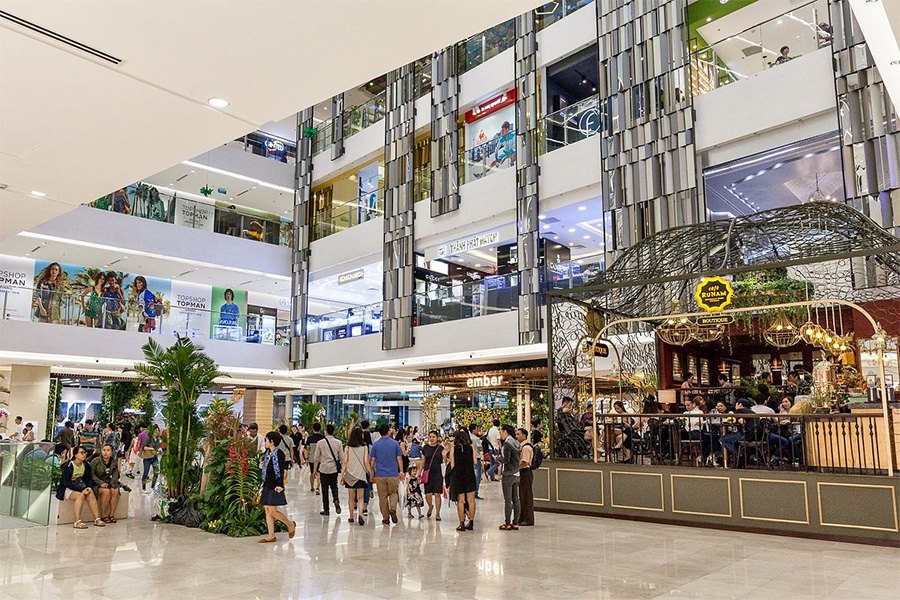
Whenever you feel like shopping in Saigon, get to Takashimaya Center (Saigon Center), a super-duper department store chain covering a wide array of products. The mixed-use complex has a total area of 15,000 square meters included in the expansion project of Saigon Center in front of Le Loi Street, intersecting with many dynamic busy streets in the heart of District 1. The giant shopping mall is filled with hundreds of retail stores, which attract customers and visitors, especially on weekends. Besides shopping, the complex hosts a variety of restaurants and other stores. Even the onsite theme-based decorations due to the events of the year look so photogenic, glittering, and beautiful that call for guests to come. The young Saigoneses love shopping, eating, and gathering in this splendid mall. This is the cradle in which numerous Instagram-worth pictures have been captured.
Landmark 81 Building
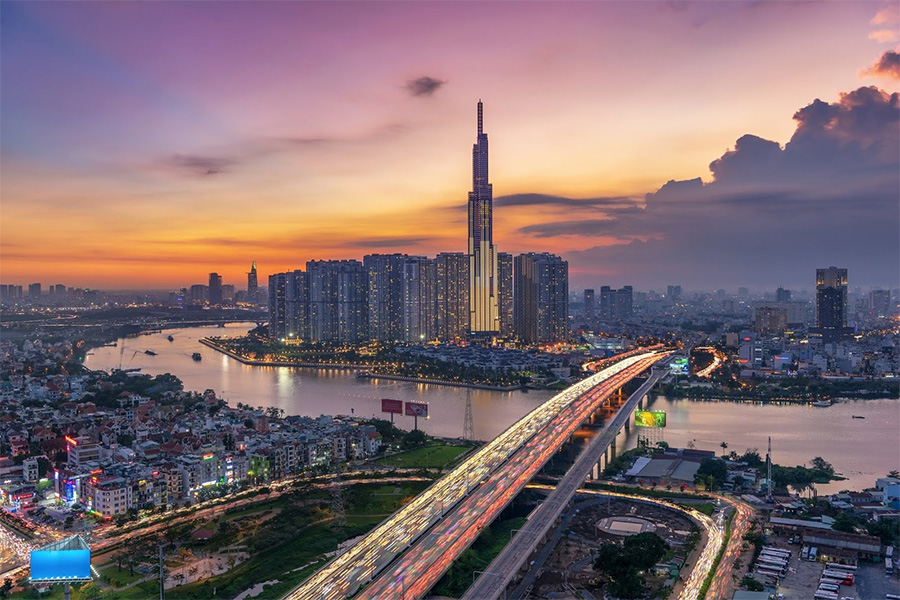
Landmark 81 is the tallest building in Vietnam, the second tallest building in Southeast Asia, and the 17th tallest building in the world. The super-tall skyscraper marks the innovative face and is among the must-see attractions in Ho Chi Minh City in a race of the tallest buildings. This property belongs to Vinhomes, a Vietnamese real-estate corporation. The site has 81 floors, at a height of 461,2m. It’s constructed on the western banks of the Saigon River, offering a spectacular view. The tower is at the center of the upscale mixed-use urban area named Vinhomes Central Park, which consists of luxury apartments, restaurants, bars, etc. The construction of this super skyscraper is between 2014 and 2019 when the observation Skyview opened to the public. The Skyview spanning from floor 79 to floor 81 is currently the highest observation deck in Vietnam. To enter the deck, you need to buy a ticket. Due to the super height, Landmark 81 is visible from almost every city corner. The tower at night looks amazingly artistic and awesome by thousands of electric lights.
Saigon Zoo and Botanical Gardens
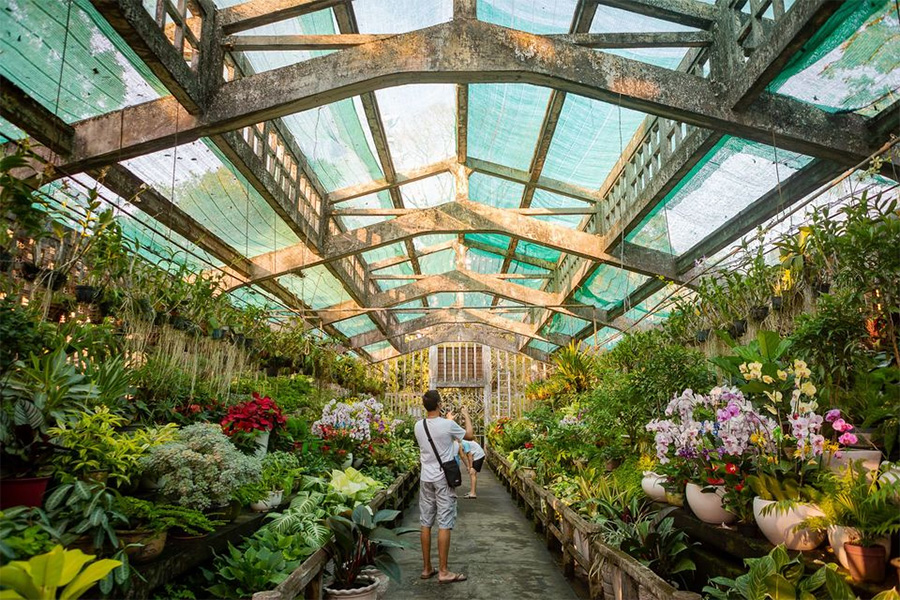
Situated on Nguyen Binh Khiem Street in District 1, Saigon Zoo and Botanical Gardens have long been a favorite hangout venue for adults and kids. People enjoy taking their children to the zoo to breathe the fresh air in the city, witness the animals, learn about them, and have a happy walk. The zoo hosts over a hundred species of mammals, birds, reptiles, and many rare orchids, plants, etc. It was founded in 1864 as the largest zoo and botanical garden in Vietnam. Parts of the zoo are divided into the orchid garden, amusement park, and animal and plant conservation zones. In the center of the dynamic city, it’s precious to preserve the green landmark that the Vietnamese often gather when they demand nature-friendly experiences, especially for their kids. The visit to the Saigon Zoo and Botanical Gardens also helps to educate the public and protect the animals and the plants. Each year, the zoo welcomes around 3,200 students to visit, listen to an hour-long lecture and watch a 3-minute film about animal and plant conservation. It’s also where people study Southeast Asia’s flora and fauna.
Cu Chi Tunnels
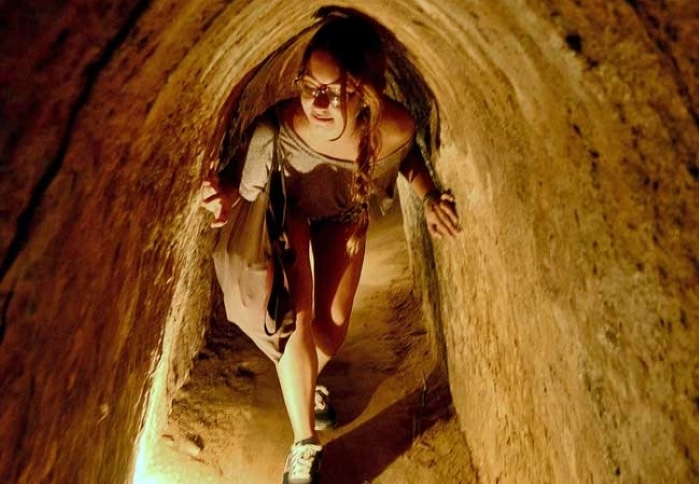
About 70km northwest of Ho Chi Minh City, the historic Cu Chi Tunnels remain attractive to history fanciers. It is a giant outdoor museum for people to be back in time. It provides back-in-time adventures in which you can take a glimpse of the hideouts in the underground constructions. You can also climb through the long and narrow passages until reaching the gateway. Make sure to check your size and shape before entering the entrance. The tunnel system of Cu Chi is 200km long, preserving the remnants of the Viet Cong. It was constructed by Viet Minh guerillas during the 1960s and 70s when the locals fought against the French, and then the U.S. army-backed Southern Vietnamese government. The system consisted of sleeping quarters, hospitals, meeting rooms, and kitchens that went through massive bombs.
The tunnels today serve as a historical attraction for generations to study, recall, and witness. The locals call it “the steel city” or the “underground city” that victoriously overcame the harsh wartime. A day tour from Saigon to Cu Chi has been booked by tourists. In the tunnel, you can try climbing through chambers underground to feel how difficult it was to live, work, and fight in such conditions. The place also preserves some remains of wars and the handmade weapons exhibited on the spot, which are great resources for Vietnamese history projects. The must-eat food in Cu Chi is the cassava steamed with coconut milk, and some guests even buy kilograms. The cassava is best served with a special drink including sugarcane mixed with durian.
Can Gio Mangrove Biosphere Reserve

Can Gio Mangrove Biosphere Reserve is around 40km southeast of Ho Chi Minh City. It is the lung of Saigon and the green weekend retreat, attracting Saigoneses and overseas tourists. The verdant mangrove ecosystem is a precious environment for city people to relax, unwind, and befriend nature. After busy and stressful weekdays, people enjoy driving from Saigon to Can Gio to breathe the fresh air, marvel at the mangrove forest, and enjoy the boat trips. Ecotourism in Can Gio is great as long as you’re interested in the wetland bio-system of mangroves and rare species. As one of the most important wildlife sanctuaries recognized by UNESCO in 2000, Can Gio is worth visiting to see a diversity of mangrove plant species, the regional fish, shellfish, etc., which live in terraces of mangroves, salt marshes, wetlands, seagrasses, and mudflats. The Site helps absorbed carbon dioxide and polluting agents of the busy Saigon. So, if you want an eco-friendly escape from the city, let’s take a drive to Can Gio and enjoy its ecotourism activities like catching fish in the mudflats, taking motorboat trips across the mangrove lines, watching birds, and off-the-beaten-track trekking. Traveling a bit far, you can drive to the 30/4 Beach, which is pristine. During the drive, stop by the thatched-roof houses for cups of water coconut for the cooling effects.
Ho Chi Minh City is a must-see destination in most of Vietnam tours overland:
Vietnam tour 12 days from South to North
Vietnam tour 15 days from North to South
Introduction to Ho Chi Minh City ‘s Best Accommodations
There are hundreds of hotels and guesthouses in the bustling Ho Chi Minh City that expand your choices to un-limitation. Each district hosts great accommodation addresses to stay, which come at a variety of prices and services. Some of the top luxury names are The Reverie Saigon, Caravelle Saigon, Sheraton Saigon Hotel & Towers, Sherwood Residence, Hotel Majestic Saigon, InterContinental Residences Saigon, New World Saigon Hotel, Park Hyatt Saigon, Sofitel Saigon Plaza, Vinpearl Luxyr Landmark 81, and Renaissance Riverside Hotel Saigon. These names are so famous for their super-duper luxury that guarantees everybody’s experiences, and none wants to leave these lavish hotels. The list might last pages and again, with no limitation. If you’re looking for the new and more budget names, here are several recommendations:
The Myst Dong Khoi
The hotel features spacious and nicely decorated rooms. Guests can find joy in the pool, steam room on the rooftop, and panoramic bar with a busy city view. The onsite spa provides relaxing and soothing effects. The room comes equipped with every amenity you need for a comfortable stay. The Myst Dong Khoi also offers complimentary afternoon tea, which is a not-to-miss service. Each corner of the site is Instagram-worthy.
The Hotel Des Arts Saigon Mgallery Collection
The hotel offers a spectacular view of Saigon, especially during sunset. It also has a picturesque rooftop bar and outdoor swimming pool for optimal relaxation while each room is elegantly designed with classic furniture, hardwood floors, and lavish beds. The comfortable room is where you might never want to leave and will miss for a while. The stay in this cool-name hotel is definitely one of the best choices you ever make during your Saigon adventures.
Cochin Zen Hotel
Located nearby the well-known Ben Thanh Market, Cochin Zen Hotel has beautifully decorated rooms and modern décor in each detail. Several rooms even host a romantic outdoor tub for amazing relaxation. Also, find pleasure in swimming at one of the three pools or relaxing in the sauna and steam room. When you want a glass of wine, head towards the rooftop bar. The city view during the sunset from this hotel is unforgettable. It is a perfect retreat to stay away from the life bustle.
Fusion Suites Saigon
As long as you’re interested in the modern décor and spa treatment, then the stay in Fusion Suites Saigon can please you surely. The chic site is located in District 1 and adjacent to the shops, restaurants, and other city landmarks. While you will enjoy the spacious rooms, the others are happy to get the complimentary spa service and somebody can have fun at the fitness center, onsite restaurants, and indoor-and-outdoor lounges. The stylish and lovely hotel can win your compliments during the actual experiences.
Silverland Yen Hotel
If you like the rooftop pool overlooking the breathtaking city view and cocktail specials, then you will love Silverland Yen Hotel. Together with the special rooftop pool, this hotel has quick access from Ben Thanh Market. The room features classical décor and amenities for your comfort. Soaking in the stunning city views and being pampered by the cozy bedding are what you need to relax during your Saigon tours.
Introduction to Ho Chi Minh City ‘s Food to Eat
Each step you go, there stand out the good eateries to eat. Known as one of the best cities with top street food in the world, Saigon won’t disappoint you with the food served on the roadsides. Sometimes, you might enjoy sitting on the plastic stools and using the Vietnamese chopsticks to enjoy the hot noodle soups. This way, you’re eating like the locals. The local food is sold at cheap prices, and you can serve a day in Saigon at merely USD 5. The city owns the cuisine of the South, the Central, and the North, resulting in a rich list of food to eat in Saigon.
Banh Mi (Vietnamese sandwich)
The Vietnamese love “Banh Mi,” which is the unmistakable truth. Almost every street corner in Saigon has the “Banh Mi” food stalls that serve a variety of sandwich choices. People mostly choose it for quick breakfast which can be eaten on the way to the offices. You can decide what should be included in your sandwich, such as the grilled pork, pate, fried egg (omelet), meatball, shredded chicken, etc. Along with that, added to the Vietnamese sandwich are the pickles, slices of cucumber, coriander, chili, and pepper. If you cannot endure the spicy taste, remember to inform the vendors in advance so that they won’t put chili in your food. During a Saigon Tour, it’s a common sight to see the locals stopping by the street food carts and buying the sandwiches for breakfast, lunch, and even dinner. You can also easily recognize the available fillings and decide your preferred ones. Due to the chosen fillings, the food prices might vary a bit. Make sure you explore how the “Banh Mi Saigon” is and evaluate the taste. This is one of the must-eats and must-dos in Saigon.
Pho (beef or chicken noodles)
Pho is a culinary pride of Hanoi and the entire Vietnam. You can find “Pho” in almost every city in Vietnam, yet Saigon is among the best places. The Saigoneses enjoy “Pho” too, which comes in the beef or chicken version. The soul of the food is the nutrient broth processed by stewing the beef bones for a long period. As usual, the vendors will ask for customers’ preferences about ingredients to be added to their bowls. You can opt for the soup with beef slices, beef meatball, beef flank, chicken, sausage, etc. Also added to the bowl are bean sprouts, lime, mint, basil, onion, spring onion, etc. “Pho” has the dominant presence in Saigon from the luxurious restaurants to the cheap street vendors. This kind of beef soup has healthy remedial effects, so it is the top culinary choice for the locals, especially when they want to treat their belly nicely or after they recover from sickness. The Vietnamese Pho is so delicious and fragrant that no tourist refuses.
Com Tam (broken rice)
Rice is the major component in almost every Vietnamese family meal. Some elders insist to have plain rice in their meals. While somebody enjoys the glutinous rice, the others like the broken rice version (Com Tam in Vietnamese). The rice is served on a plate and topped with several types of toppings, like barbecued pork ribs, omelets, shredded pork skin, steamed pork-and-egg sausage, cucumber, and pickles. Foodies can decide on the toppings they prefer on their plates, and the food prices vary due to the chosen ingredients. As usual, pork rib is the best-seller. The food will be served with well-spiced sweet-and-sour fish sauce. People can add slices of chili to the sauce if they want it to be spicier. As a must-eat in Saigon, the broken rice food is associated with the Saigon cuisine brand. Plates of “Com Tam” have been enjoyed by the locals and visitors, who together agree that Saigon is the best city with the best “Com Tam.” You might find the broken rice in other cities, believably, but the one in Saigon is still the best brand. Not only does the plate look eye-catching but it’s also mouth-watering.
Bun Rieu (noodle soup with crabmeat)
Ho Chi Minh City is a paradise of soups as there are dozens of soups to enjoy. The noodle soup with crabmeat (Bun Rieu Cua in Vietnamese) is a yummy choice featuring the crab-based broth added with meatball, fried tofu, pork ribs, sausage, and tomato. The healthy balance is supported by some greens and herbs. This kind of seafood soup might make people “addicted” to its taste. While somebody enjoys the crab paste the other fall in love with the broth. Some patrons are even willing to drive a bit far to eat “Bun Rieu Cua” if their areas do not have dedicated food carts. Though this kind of soup might not as be popular as the famous “Pho,” this southern soup is worth savoring and again, its sweet taste might make you addicted. The soup is often served with shrimp paste, which has a strong smell and might not fit everybody. Thus, smell the shrimp paste before taking it out.
Banh Xeo (Vietnamese pancake)
The pancakes of the Central Highlands and Mekong Delta regions are scattered throughout Saigon. Imported into Saigon, the pancake versions seem to be modified a bit to adapt to the local circumstances, and the Saigon pancake is one of the top favorites. It features a crispy cover and delicious fillings. The pancake is made of rice flour mixed with turmeric and coconut milk for frying in the pan. Then, it’s stuffed with pork, shrimp, green bean, bean sprout, and onion. Foodies can enjoy Vietnamese pancakes as snacks or appetizers. There are ways to enjoy the crispy cakes like putting every component into a bowl and soaking it in the fish sauce. Another way is to use rice papers and vegetables to wrap the pieces into rolls and then dip the entire rolls into the sweet-and-sour fish sauce. The city hosts a variety of food carts selling the pancake versions of the central highlands and southern Vietnam. As usual, the southern pancakes have a bigger size than the central ones. Meanwhile, the central pancakes have a crispier cover.
Hu Tieu (rice vermicelli soup)
“Hu Tieu” is among the most popular types of rice vermicelli pork soup in the city streets, filled with many dedicated food carts. It is a top choice for everybody that seems fed up with the plain rice meals and is looking for hot soup. People find it super-easy to find the carts selling “Hu Tieu,” and some shops even serve 24/24. The after-midnight street carts sell “Hu Tieu Go” while “Go” refers to the knock on the cart that the vendors strike a surface noisily to attract customers’ attention in the evenings. The common soup versions include pork ribs, shrimp, squid, and fish, but the top pick is the pork rib soup. Some street vendors even add quail eggs into the soup. The food must be served hot and help warm up your bellies in the late nights. A real experience in Saigon night will let you come across the common scene where many Saigoneses are gathering on the “Hu Tieu” carts. Patrons agree to share their tables with the strangers who are strange but share a common love for this hot soup.
Bun Thit Nuong (rice vermicelli served with grilled pork)
The fame of Vietnamese “Bun Thit Nuong” has reached international contexts, and many foreigners even try making this food in their homes. While the grilled pork can be easily made, as you know, the success of the food might lie in the fish sauce and other ingredients like the roasted peanuts, rice vermicelli, etc., and a variety of herbs and vegetables used. The vendors might add slices of cucumber, mint, carrots, bean sprouts, and lettuce into the bowl. The highly enjoyed ingredient is the crispy spring rolls. While the ingredients are put into the bowl, the fish sauce should be served in a separate small bowl so that foodies can add the amount as they prefer and further spice it with more chilis. When you’re in Saigon, make it a must to taste this food for breakfast, lunch, or dinner. A simple version of the food includes rice vermicelli, grilled pork, some lettuce, and roasted peanut only. Many Vietnamese families enjoy making the dish at home with basic ingredients, which are still good. Therefore, eat it once and then you can try it at home.
Bot Chien (fried rice cake)
The fried rice cake is a specialty of Saigon. Before being fried in the large hot pan, the rice cakes will be cut into small pieces. Once ordered, the chefs will add egg, spring onions, shallots, and several seasonings to the being-fried cake pieces until they become golden brown. When all ingredients are mixed well, they will be put on a plate and served together with a small amount of soy sauce. The rice cakes should be eaten hot when they are still crunchy. Some vendors might serve this food with slices of papaya. “Bot Chien” can be served in the local markets and is the favorite food choice of the local kids. Once first introduced, this food appeals to the Saigoneses and even spread its popularity in the Mekong Delta provinces. You might not expect to find “Bot Chien” at the fine-dining restaurants or luxurious malls; rather, the food is sold at the roadside eateries, markets, and street food carts. Don’t limit your Saigon Food Tours in the restaurants merely. Instead, venture out to the Saigon streets and enjoy the yummy treats.
Introduction to Ho Chi Minh City ‘s Future Orientation
The tourism industry in Saigon nowadays is linked to the adjacent provinces, targeting sustainable growth. This orients to run tours from Ho Chi Minh City to the nearby Mekong Delta provinces, of which some are bike tours. It is a trend of weekend biking tours associated with charity activities towards pristine trails nearby Saigon namely Can Gio Mangrove Forest, Cai Be Tien Giang (Mekong Delta), Ma Da Forest, and Tri An Lake. The biking distance is between 25k m to 30km, so tourists will be heartened to overcome their limits, reach the targets, and enjoy the exciting weekend escapes. Besides, the city focuses on promoting tourism via digital transformation to better introduce the landmarks and highlights on Google Maps, Google Earth, and 3D smart interactive maps for tourists. There will be even tourism applications and websites to provide better travel guides to first-time guests. The city tourism industry also organizes online tourism fairs on 2D and 3D platforms to promote the introduction to Ho Chi Minh City ‘s new tourism products. Support is better given through the e-commerce platform. The new brand “Vibrant Ho Chi Minh City” is oriented to be advertised to domestic and international tourists.

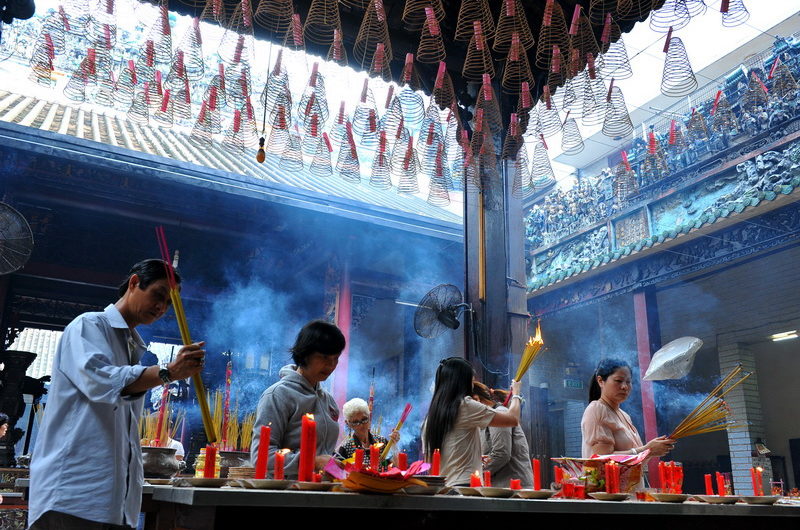
Comments